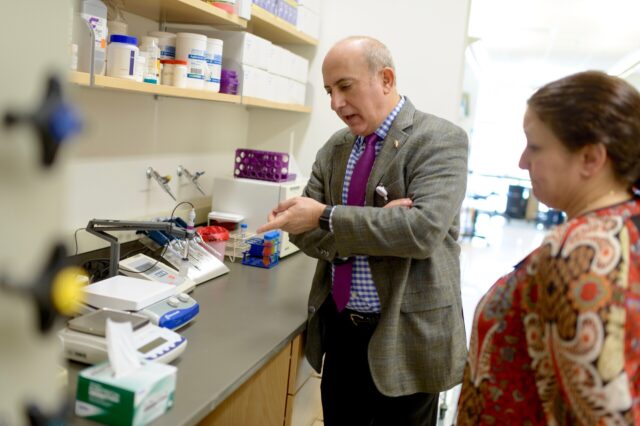UF researchers find gene mutation involved in cancer progression

University of Florida researchers have found mutation hot spots in a unique class of proteins that could drive cancer progression.
“There are recurrent mutations that are associated with cancer development,” said Jonathan Licht, M.D., director of the UF Health Cancer Center and study co-author. “Many of these mutations inactivate the functions of important proteins that prevent tumor formation and cause proteins to stimulate cancer growth. We wanted to know if there are mutations in other parts of the histone molecule.”
Prior research has identified mutations in proteins known as histones that lead to abnormal gene regulation in cancer cells, Licht said. Histones help package DNA in cells so DNA can be protected from stresses and compacted into chromosomes during cell division.
There are four types of histone proteins — H2A, H2B, H3 and H4 — that form together, two of each molecule, to create an octamer. The octamer has two wraps of DNA around it, and this unit is known as the nucleosome. Histones have an additional feature — an unstructured tail that protrudes out and signals to the cell when genes should be turned on or off.
Licht and collaborators found a new class of mutations that interrupt the structure of the histone octamer, causing the disintegration of the nucleosome and the stimulation of cancer growth.
“This histone mutation seems to cause a collaboration to make a more aggressive, angrier group of cancer cells,” he said. “This suggests that this mutation may amplify the effects of other cancer mutations, and that’s why we think it may be an important cause of cancer progression.”
The researchers used cBioPortal, a database of roughly 45,000 patient tumor sequences from around the world, to observe whether there were mutations in histone genes and, for each one of the histone genes, how often it mutated in cancer, Licht said.
Mining through the data within cBioPortal resulted in the new discovery.
“We found hot spots,” Licht said. “Many of the hot spots were predicted to affect the structure of the histone octamer so that it wouldn’t properly form.”
Some of these mutations had been identified in previous studies, but this study was a more comprehensive look into histone mutations, he said. The group characterized one mutation in particular, an H2B histone that caused the histone octamer to fall apart instead of coming together, resulting in abnormal gene expression that could contribute to cancer.
The researchers also found the mutation was most commonly found in tumors that tend to have high rates of mutations such as cervical cancer, and tobacco-related tumors such as head and neck cancers.
The group tested the mutation by adding it to breast cells, Licht said. The addition of the histone mutation to the breast cells caused them to grow. Even more significant, when the histone mutation was co-expressed with PI3KCA, a cancer-causing mutation commonly found in breast cancer that affects signaling pathways, it caused a stronger cancer-like outcome and the growth was highlighted.
While Licht and colleagues focused on one particular mutation in this study, there are about 20 other mutations, many of which are predicted to also cause the nucleosome to fall apart. These are now being studied to understand how they collaborate with other cancer-causing genes.
Further research is needed to see how the mutations exactly affect cancer progression, if the mutations make cancer more aggressive and how they can be therapeutically targeted.
“One next step is to understand how exactly this histone mutation collaborates with other cancer-causing genes,” Licht said. “We don’t think this mutation is the root cause of cancer. It's something that the cancer accumulates as it progresses.”
This study was published in the October issue of Cancer Discovery and funded by the National Cancer Institute grant for Physical Sciences-Oncology Centers (U54). It included collaborators from Northwestern University, the Dana-Farber Cancer Institute, Stanford University, the University of Chicago and Tennessee Technological University.
About the authors

